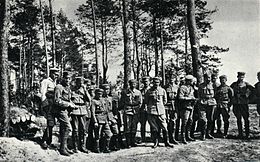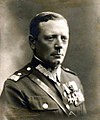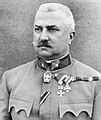Polish Legions in World War I
| Polish Legions | |
|---|---|
| Legiony Polskie | |
 Europe in 1914, the Central Powers in brown Europe in 1914, the Central Powers in brown
Governor's Palace in Kielce , 1914
 Col. Józef Piłsudski and his officers, 1915 Col. Józef Piłsudski and his officers, 1915
 Pilsudski in Otwock, 1915 Pilsudski in Otwock, 1915
II Brigade of the Polish Legions in Volhynia c. 1915-16 |
The Polish Legions (
The Legions took part in many battles against the forces of the
History
According to Prit Buttar, "When war broke out, Piłsudski was quick to recognize that an important preliminary step in Poland's path to independence was the defeat of tsarist Russia..." Piłsudski was no supporter of the Central Powers, and once Russia had been driven out of Polish territory, he believed that he and his fellow Poles would have to persuade the Germans and Austro-Hungarians to leave too, but he held secret meetings with representatives of France and Great Britain to make clear to the western members of the Entente that Polish troops would never fight against them, only against Russia."[6]
The formation of the Legions was declared by Józef Piłsudski in his order of August 22, 1914. The Austrian government, having jurisdiction over the area, officially agreed to the formation on August 27, 1914.
The unit became an independent formation of the
Initially, the Polish Legions were composed of two legions: the Eastern and the Western Legion, both formed on August 27. After a Russian victory in the
- Artillery Battalions with served with I, II, and III Brigade
- Cavalry Regiments: 1st served in I Brigade; 2nd served in II Brigade; 3rd served in III Brigade
- Infantry Regiments: 1st, 5th, 7th served in I Brigade; 2nd, 3rd served in II Brigade; 4th served in both II and III Brigades; 5th, 6th served in III Brigade.
The commanders of the Legions were consecutively: Gen.
| Operations of Polish Legions and the Puławy Legion | |
|---|---|
 |
Battles
Below is a list of prominent Polish battles against the Imperial Russian Army in 1914–16, leading to victories in most cases, with notable exceptions especially during the
- Battle of Nowy Korczyn (23–24 September 1914)
- Battle of Laski and Anielin (October 21–October 26, 1914)
- Battle of Mołotków (October 29, 1914)
- Battle of Krzywopłoty (17–18 November 1914)
- Battle of Marcinkowice (5–6 December 1914)
- Battle of Łowczówek (December 22–December 25, 1914)
- Battle of Pustki (2 May 1915)
- Battle of Konary (May 16–May 25, 1915)
- Battle of Rafajłowa (January 23–24, 1915)
- Kirlibaba (January 18–22, 1915)
- Rarańcza (June 13, 1915)
- Battle of Rokitna (15 June 1915)
- Battle of Jastków (July 29–July 31, 1915)
- Battle of Kostiuchnówka (July 4–July 6, 1916)
- Battle of Rarańcza (15–16 February 1918)[7]
Notable officers who served in the Polish Legions
Following the foundation of the Second Polish Republic, many served in the Polish Army, and held political as well as elected offices.
Polish Legions' prominent members
-
Wacław Kostek - Biernacki
-
Bronisław Duch
-
Emil Fieldorf
-
Józef Haller de Hallenburgwho commanded II Brigade
-
Tadeusz Jordan-Rozwadowskiin an Austro-Hungarian military uniform, 1918
-
Marian Kozielewski
-
Mieczyslaw Norwid-Neugebauerwho commanded 6th Regiment and 3rd Brigade
-
Leopold Okulicki who served in 3rd Legions Infantry Regiment
-
Gustaw Orlicz-Dreszer
-
Władysław Raczkiewicz (President of Poland)
-
Tadeusz Różycki-Kołodziejczyk
-
Waclaw Sieroszewski
-
Oath Crisis
-
Kazimierz Stamirowski
-
Michał Karaszewicz-Tokarzewski
-
Zygmunt Zieliński
See also
- Polish Legions (disambiguation)
- Stanisław Skarżyński
- Czesław Zbierański
- Association of the Polish Youth "Zet"
- Blue Army (Poland)
- First Cadre Company
- Greater Poland Uprising (1918–1919)
- Kingdom of Poland (1916–1918)
- List of Polish divisions in World War I
- My Pierwsza Brygada
- Polish Army Veterans' Association in America
- Polish Legion of American Veterans
- Polish Auxiliary Corps
- Polish I Corps in Russia
- Polish II Corps in Russia
- Polish 1st Legions Infantry Division
- Polish Military Organisation
- Polish Rifle Squads
- Polska Siła Zbrojna
- Riflemen's Association
- Union of Active Struggle
- The Seven Lancers of Belina
External links
- Centek, Jarosław: Polish Legions , in: 1914-1918-online. International Encyclopedia of the First World War.
- Brudek, Paweł: Polish Legionaries Union , in: 1914-1918-online. International Encyclopedia of the First World War.
Notes and references
- ^ ISBN 978-0-19-965881-7.
- OCLC 52541937.
- ^ WIEM Encyklopedia (2015), Polski Korpus Posiłkowy at PortalWiedzy.onet.pl (in Polish)
- ISBN 0-8153-3351-X– via Google Print.
- ISBN 978-83-7001-914-3.
- ISBN 978-1-4728-2489-9.
- ^ Piotr Galik, Chwalebna zdrada: Rarańcza 1918. Fakty.Interia.pl at Internet Archive. (in Polish) See also: Mieczysław Wrzosek, Polski czyn zbrojny podczas pierwszej wojny światowej 1914-1918, Państwowe Wydawnictwo "Wiedza Powszechna", Warszawa 1990.
























































